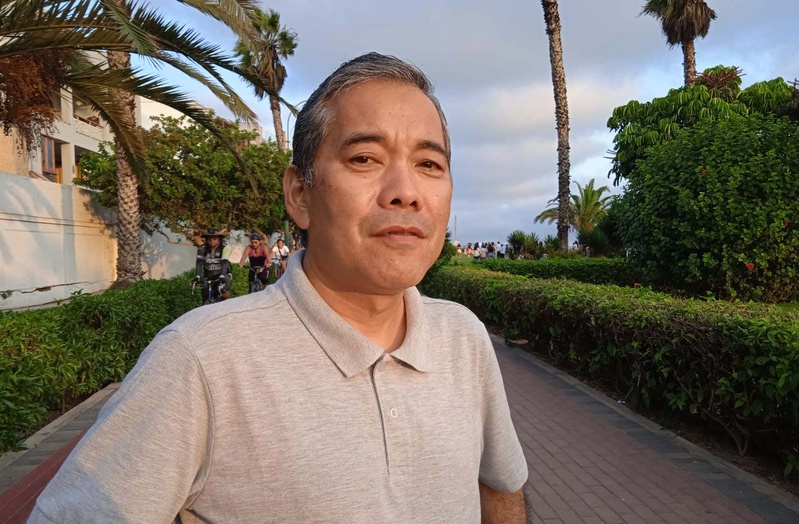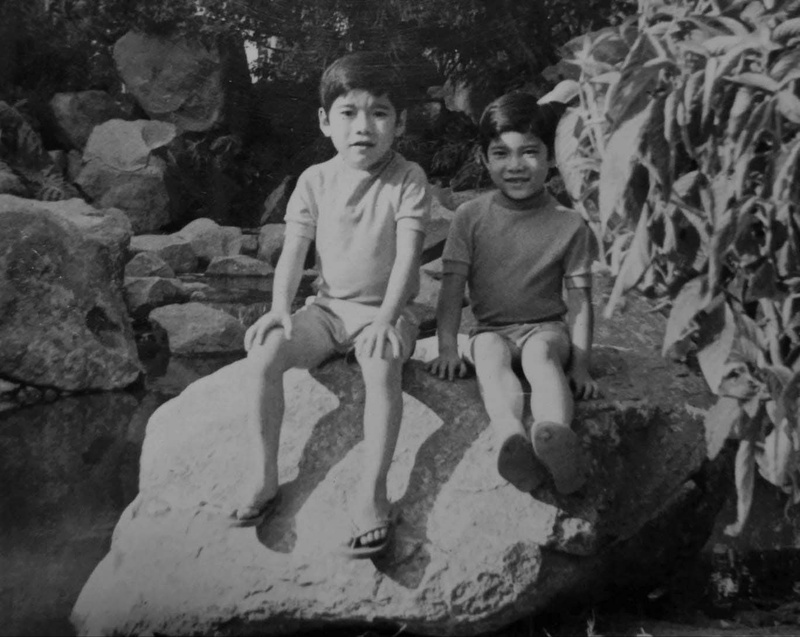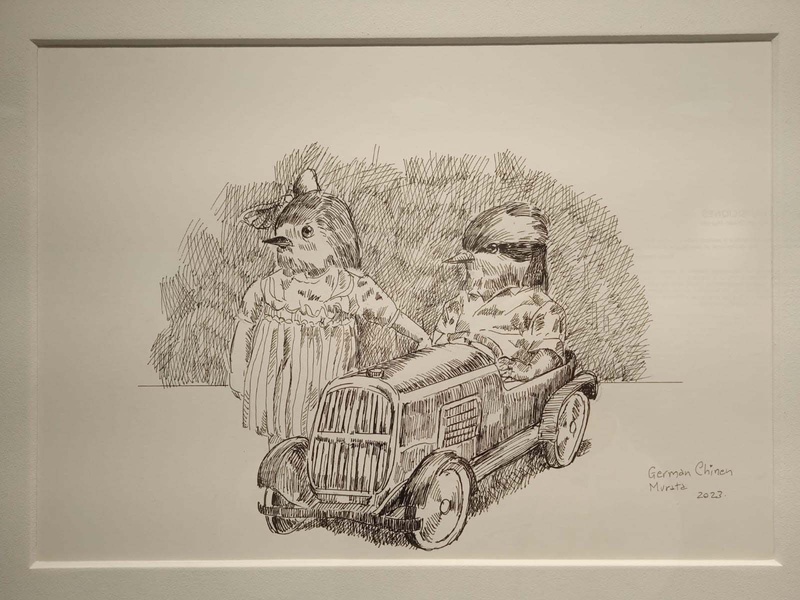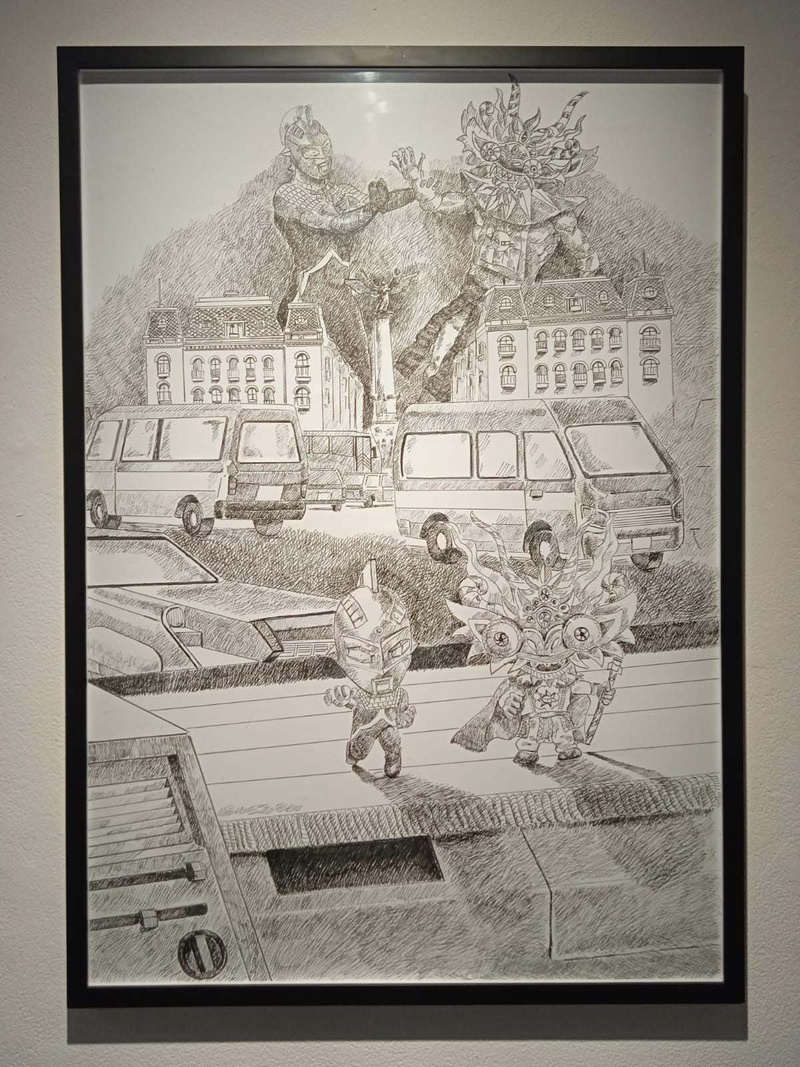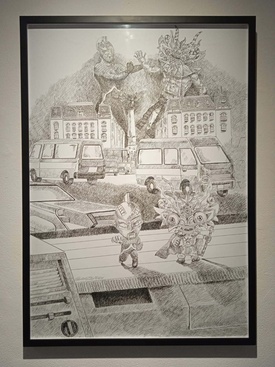The story of German Chinen Murata (Lima, 1967) can be told as if it were a comic strip. The synopsis would be: a Peruvian Nikkei pursues his dream of being a cartoonist, but along the way he must travel to Japan to work, returning to his country to be a drawing teacher until one day he manages to have his own individual exhibition. His superpower? The persistence. Despite being a secret artist for many years, he maintained his dream of publishing the drawings he saw since he was a shy child.
The profile of the protagonist would be: of Japanese parents, German was born in Lima and grew up in the Miraflores district, where he began his interest in drawing. “I was one of those kids who always drew, I started collecting comics and I went to Surquillo to exchange them at second-hand positions and also at school.” He copied those drawings, the superhero comics, and then he moved on to Spanish and Argentine graphic novels about warriors and mafias.

The stylized designs, with more textures than those found in comics, were a trademark of his drawing style that prevails to this day. “The crossed lines, without much contrast, I acquired it in 14 inches, without cable, and there he met the characters who would reappear in his most recent exhibition , in the Ryoichi Jinnai gallery of the cartoonists, Juan Jiménez, Alberto Brescia…” says German. Like every child, during those years I was glued to the television, a black and white one, from the Peruvian Japanese Association (APJ), at the beginning of June.
Heroes of yesterday and today
Under the title Transitions , Chinen presented his first individual exhibition, a “personal story in which he explores his Peruvian and Japanese cultural heritage,” said Erica Olivera Kanna, director of Culture at APJ. In his pencil drawings are those characters from Peruvian TV from the seventies and eighties imported from Japan: Astroboy, Ultrasiete and Ultraman, among others who occupied his afternoons and mornings.
“I couldn't draw them because it was difficult to retain the details on the screen, I needed the static figure to be able to copy them.”
But he did get hooked on the stories. “I learned a lot about Japan thanks to these cartoons, about what people were like in the suburbs. The heroes were ordinary boys, heroes almost by chance.” Along with them, other fantastic beings appear, anthropomorphized animals (roosters, dogs, foxes, birds) in environments that reflect their cultural influences from Japan and Peru.
“I studied at Mariano Melgar de Breña, I remember that in the entire school there were only two Japanese. I was not close to the Japanese community, I was small and quiet, very shy.”
At 55 years old, German Chinen sat down to draw the memories of his childhood, those of television and those of his family and Japan (with historical references such as Masaichi Tanaka's soda factory that was devastated by the mobs that in the during the Second World War he looted Japanese businesses).
So, he went back to being a child to recreate them in the Peruvian context that he saw, back in the eighties, before traveling to Japan to work as a worker. There could begin the crux of his story, when he must leave Peru at the age of 28, after having studied engraving at the School of Fine Arts.
art or work
In Japan, German Chinen had to forget about art for a while. Between 1991 and 1992 he was alone, in Gunmaken, it was the first time he left Lima and he was in a car assembly plant at the Daihatsu factory. “It was a very hard experience, I was with workers, not with intellectuals,” says German, who remembers that they read the Peruvian newspaper El Comercio several times from a month ago, and watched recordings of the Peruvian league goals.
“I lost my job due to staff reduction and I had to renew my visa, but since I didn't have a contract I decided to return.” Already in the second stage, between 1996 and 2000, he was with his family and was able to learn more about Japanese culture.
“I participated in a painting contest… there was an urban art exhibition, they were banners that were hung in Gifu. Then I went to an air conditioning factory, full of Peruvians. I lived with my mother, my stepfather and brothers, it was more bearable… there were always things to do.”
During those years, German took a trip to Canada, where he went to study, but ended up staying, doing a little bit of everything to survive, including a language school where he learned French. There he received the Lieutenant Governor of the Province of Quebec Award for academic merit.
“I made commissioned art for friends, and I returned to Peru in 2008.” He worked as a photography and drawing teacher, but that was a very different city from the one of his childhood. “I had not returned to Peru since 1996, I was amazed by the changes, except for the street vendors and the traffic, but I felt at home.”
Back to art
Back in Lima, German felt a bit strange in a big city. “I had been in quiet countries and I didn't know if I was mentally prepared, it was a bit difficult for me, even though I lived my adolescence during the time of terrorism.”
As a drawing teacher he made several characters in chalk and marker that he then immediately erased. A good title for his comic could be “The Secret Cartoonist” because until that time only his students could see his work on the blackboard for a few minutes.
He spent a long time without publishing or participating in exhibitions until 2013, when he presented some works in group exhibitions. In 2019, he began working on the drawings that he would include in his most recent solo exhibition that had to be postponed due to the pandemic. “It was what I had always dreamed of, it had already been approved and the pandemic just hit. He was waiting for three years,” says German, who remembers that he always wanted to exhibit at APJ ever since he opened his gallery, when he was about 20 years old.
A few years earlier, in 2020, he participated in the audiovisual project “Don't ask me to return”, by director Reichart de Alcocer, which brought together several artists in order to “raise awareness in society and government institutions to confront and defeat the COVID-19 through solidarity” 1 . Chinen participated with some drawings that were used to illustrate a short film. But it was with Transitions that his greatest desire was achieved, and with the help of his girlfriend Jimena Suárez, who was the curator of the exhibition.
Last chapter
“I thought about having fun, what is shown is a work that I have loved doing, that has taken me some time, but the personal satisfaction in the gallery and the response of the people has made me very happy,” says German who, as a character incognito, he sometimes listened to the public's comments and loved that it brought joy to adults, who were reunited with characters from their childhood, and to children who saw in the format of comics and superheroes a new connection with art.
He says that there are still many characters in the pipeline and that there are other television series that are part of his imagination, but that were not enough for this exhibition that included 30 drawings and an installation, such as “The Planet Prince” or “The Knight Princess”; Not to mention his bestiary of characters that are linked to Peru and Japan, which may be enough for a book. “I think that everyone in Peru has something of Japanese culture,” says German, who, hidden in his Nikkei eyes and his evasive gaze, goes unnoticed as a secret cartoonist, the character of a comic book to be written.
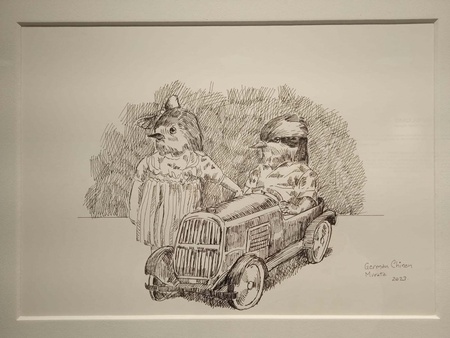
Note:
1. Kiara Barrios, “ Everything that was before the quarantine has to change ,” Lamura.Pe (May 31, 2020)
© 2023 Javier García Wong-Kit


